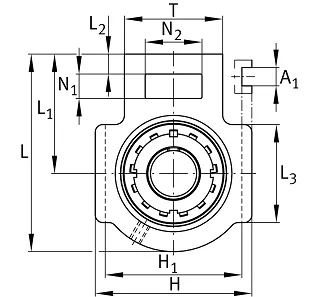Nov . 16, 2024 13:19 Back to list
motor pump bearing
Understanding Motor Pump Bearings Importance, Types, and Maintenance
Motor pump bearings are critical components in various industrial applications, serving as the interface between the rotating elements of a motor and the stationary components of the pump. Their primary function is to support the shaft, reduce friction, and ensure smooth operation of the motor and pump system. Given their importance, understanding the nature of motor pump bearings, their types, and maintenance requirements is essential for optimal performance and longevity of the equipment.
The Importance of Motor Pump Bearings
Bearings play a vital role in the overall efficiency and effectiveness of motor pump systems. They facilitate the smooth rotation of the motor shaft, which drives the pump to move fluids within a system. The right bearings reduce wear and tear on both the motor and pump, minimize vibration, and decrease the chances of mechanical failure. Efficient motor pump bearings contribute to energy savings, as less friction leads to lower power consumption.
In addition to their operational benefits, well-maintained bearings can significantly extend the lifespan of both the motor and pump. This not only enhances productivity but also reduces the need for costly repairs or replacements, ultimately leading to lower operational costs.
Types of Motor Pump Bearings
When it comes to motor pump bearings, several types are commonly used, each with its specific characteristics and applications
1. Ball Bearings These are the most commonly used type of bearings in motor pump systems. They are designed to handle both radial and axial loads and are known for their ability to operate at high speeds. Ball bearings are versatile and suitable for most industrial applications.
2. Roller Bearings These bearings utilize cylindrical rollers instead of balls, which can handle higher radial loads compared to ball bearings. They are particularly beneficial in applications where heavy loads and lower speeds are prevalent.
3. Thrust Bearings These are designed to support axial loads and are typically used in conjunction with other bearing types. Thrust bearings ensure that the motor shaft does not move axially, providing stability to the motor pump system.
motor pump bearing

4. Magnetic Bearings In advanced applications, magnetic bearings are used to eliminate physical contact between moving parts. This reduces friction and wear, allowing for greater efficiency and eliminating the need for lubrication.
Maintenance of Motor Pump Bearings
Proper maintenance of motor pump bearings is essential to ensure their longevity and efficient performance. Here are some essential maintenance practices
1. Regular Inspections Conducting routine inspections can help identify potential issues before they escalate. Check for signs of wear, corrosion, or misalignment, as these can lead to bearing failure.
2. Lubrication Bearings require adequate lubrication to minimize friction and wear. Depending on the type of bearing and application, lubrication schedules may vary. It’s crucial to use the correct type of lubricant and follow the manufacturer's recommendations.
3. Temperature Monitoring Excessive heat can degrade bearing performance and lead to failure. Monitoring operating temperatures can help identify problems early, allowing for timely intervention.
4. Alignment Checks Proper shaft alignment is vital for the smooth operation of motor pump bearings. Misalignment can lead to increased vibration and premature wear. Regular checks and adjustments are necessary to maintain alignment.
5. Cleanliness Keeping the operating environment clean is essential for bearing longevity. Contaminants can introduce particulates that may lead to damage and reduced performance. Sealing off bearing areas and employing filters can help minimize contamination.
Conclusion
Motor pump bearings are essential components that directly influence the efficiency, reliability, and lifespan of motor pump systems. Understanding the different types of bearings, their roles, and the importance of proper maintenance can lead to improved operational performance, reduced costs, and enhanced productivity. By investing in regular inspections and maintenance, industries can ensure their motor pump systems operate smoothly and effectively for years to come.
Latest news
-
UCT218 Take Up Housing Bearing Unit Pillow Block Bearing - Durable & Reliable
NewsJul.24,2025
-
UCF206-19 Flange Housing Square Bearing Unit – Durable & Easy Installation
NewsJul.23,2025
-
UCF208 Cast Iron Square Bearing Flange Housing Unit for Heavy Duty Applications
NewsJul.22,2025
-
High-Performance 800730 Spherical Bearing for ZF M7 Mixer Reducer
NewsJul.22,2025
-
BB 15-25 One-Way Cam Clutch Bearing | Reliable Sprag Backstop
NewsJul.21,2025
-
25MM 2 BOLT UCFLX05-14 Flange bearing unit( oval)
NewsMar.07,2025





